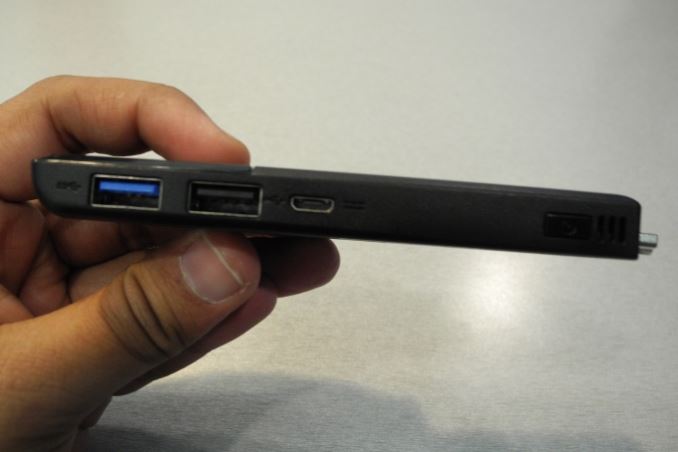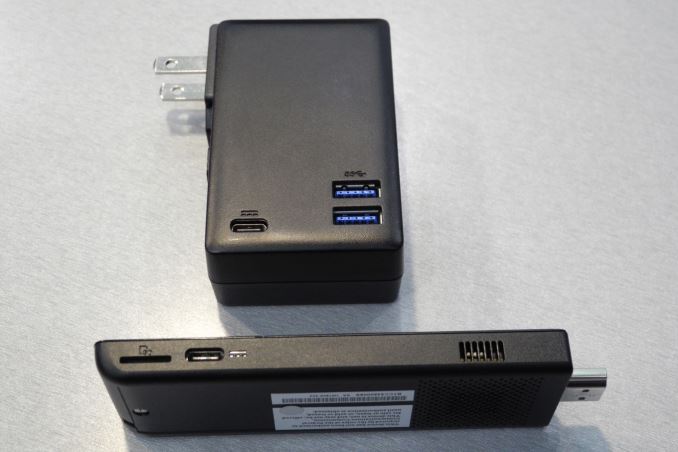Intel Expands Compute Stick Family with Cherry Trail and Core M Models
by Ganesh T S on January 11, 2016 6:00 AM EST- Posted in
- Trade Shows
- Intel
- NUC
- Mini-PC
- CES 2016
- Compute Stick

The desktop PC market is seeing growth only in two areas - the gaming high-end and the mini-PCs (in the NUC form factor). Intel has been strengthening its offerings in the latter space as a system vendor. The NUC has been extremely popular and Intel's partners such as Zotac and GIGABYTE are also enjoying a lot of success with similarly sized systems.
ARM SoC vendors started the trend of HDMI sticks, but Intel joined the game in CES 2015 with the Bay Trail Compute Stick. The first iteration was, to put it kindly, a bit underwhelming, but Intel showed its commitment to the form factor by announcing three new Compute Stick models at CES 2016.
Cherry Trail Compute Stick
This is a straight-on follow-up to the Bay Trail model from last year. The I/O ports and hardware construction are similar, except that the Cherry Trail model is slightly longer and includes a USB 3.0 port in addition to the previously existing single USB 2.0 port.
Other improved aspects include the use of Intel's own 802.11ac Wi-Fi chipset instead of the Realtek one found in the Bay Trail version. Obviously, Cherry Trail's GPU is better than Bay Trail's. However, the cooling fan still remains part of the hardware. The eMMC capacity is only 32GB and the RAM is only 2GB - two aspects that have an artificial limitation imposed on them by Intel's decision to pre-install Windows 10 Home. Even though the information is not public, it is likely that Microsoft mandates neutering of a PC's hardware specifications in exchange for a lower price for the Windows 10 OEM license.
Skylake Core M Compute Sticks
While the Cherry Trail Compute Stick was more or less expected, the Core M-based Compute Sticks were a real surprise. Later this year, Intel will launch two Compute Stick models with a Core m3 and Core m5 vPro configuration respectively. The OS will not be pre-installed, and this means that we don't need the storage or RAM to be limited by anything other than what the hardware design allows. In terms of available ports, the design retains the microSD slot from the other Compute Stick models. However, there is only one USB 3.0 port on the unit itself. Power to the unit is delivered by a USB Type-C connector.
The USB Type-C power adapter also includes two USB 3.0 ports. This is a very novel use of the USB Type-C power delivery mechanism. Intel mainly expects the Core M Compute Sticks to be popular amongst businesses and enterprises (thanks to the availability of vPro).
NUCs
Intel has been shipping the Skylake NUCs for a couple of months now. They had one on display at their booth. Interesting aspects include the presence of a SDXC slot as well as a full-sized HDMI port in the rear panel.
They also talked about the upcoming 'Skull Canyon' mini-PC featuring a 45W TDP Skylake H CPU with Iris Pro graphics. It will not be in the NUC form factor, but will be a slightly larger rectangle with height similar to the current NUCs which don't support 2.5" drives. The unit is still a work in progress, but we expect it to launch in the second half of this year. Unfortunately, Intel didn't allow us to take photographs of the Skull Canyon mini-PC.
On the whole, Intel is showing strong commitment to the mini-PC market segment. This will keep x86 relevant in the home computing space even as ARM continues to strengthen its hold in mobile computing.
















34 Comments
View All Comments
marc1000 - Monday, January 11, 2016 - link
It's really nice to see such commitment. On the last couple years, I've finally started to see my expectations from computing since the nineties come to our daily life. phones fast enough and with good integration with car audio and other accessories, computers and OS's fast and easy to work with, form factors ever smaller and more silent.moore's law may be nearing the end of the classic transistor technology, but with proper integration and presence of compute in our lifes, we may not even notice the technical aspect of it anymore.
Lerianis - Monday, January 11, 2016 - link
Actually some people have said that Moore's law is not coming to the end, that they would just have to switch to a new material to do more enhancements.WorldWithoutMadness - Monday, January 11, 2016 - link
The law would be broken if 10nm isn't out by this year. Double density every 2 years.New material? None of those are ready til 202X.
mkozakewich - Sunday, January 17, 2016 - link
Moore's Law was actually about the price of transistors, and we're finally at the point where further reductions are no longer cheaper. We'll definitely take things further, but we almost don't need to for near-future consumer goods. Expect all the sub-$100 electronics to stay in a similar power range, while the expensive stuff continues to double for a bit.Murloc - Friday, February 26, 2016 - link
almost no need?I think smartwatches badly need technological progress to be successful.
FunBunny2 - Monday, January 11, 2016 - link
-- switch to a new material to do more enhancements.not until, of if, science finds one. the first transistors were on gallium which is rare and expensive (relative to silicon) and is now being talked of as the replacement for silicon. might work from an engineering perspective, but might not from an economic one.
CaedenV - Monday, January 11, 2016 - link
Those CoreM options look fantastic!If they have a monitor with a recessed HDMI slot that could some how secure one of these inside this it would be a great option for school labs and student computers... but unless I can lock it to the monitor then they would just walk off, so that isn't good.
WorldWithoutMadness - Monday, January 11, 2016 - link
So basically AIO?This + monitors = AIO price
jjj - Monday, January 11, 2016 - link
Don't forget the pricing. They do, on purpose since if they would publish it now, everybody wold turn negative.Murloc - Friday, February 26, 2016 - link
just buy an AIO......